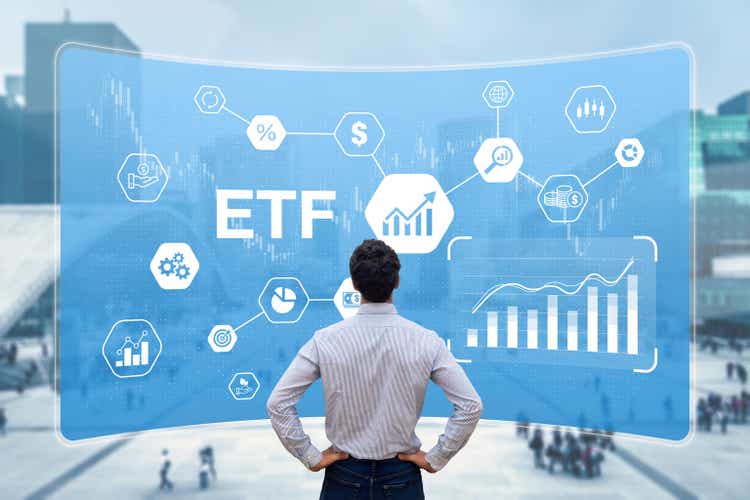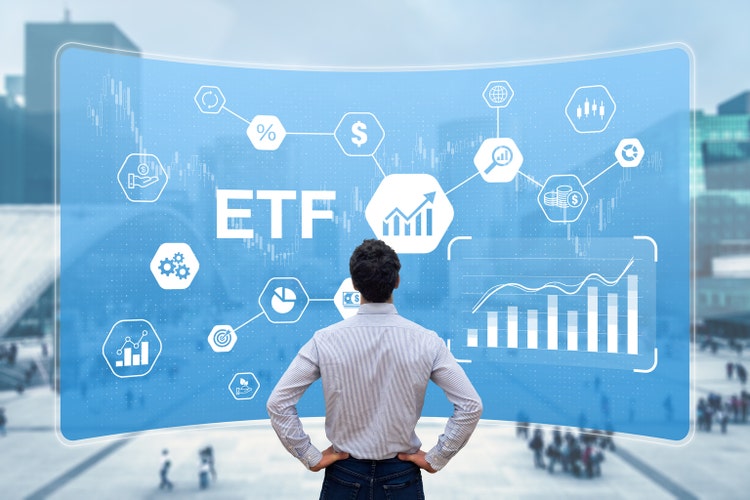[ad_1]

NicoElNino/iStock via Getty Images
[Growing supply and demand for ETFs are driving the ETF industry to a stone’s throw of the $1 trillion net inflows mark. Driving this momentum are investors and advisors heightened comfort levels in strategically and tactically employing ETFs for portfolios. Recent changes to ETF regulations have also made it easier for asset managers to launch new ETF products that offer an ever-widening variety and range of new investment opportunities.
Through mid-December 2021, CFRA reported that investors poured $904 billion into U.S.-listed ETFs, eclipsing the 2020 record for ETF flows of $504 billion. Asset managers launched a record-setting 439 new products – 30% more than the number of products currently trading that came to market in 2020 and more than the combined number of launches in 2018 (213) and 2019 (206).
To better understand the mindset and mechanics behind the innovation happening in the ETF and Index marketplace, we reached out to Institute member Gabriel Hammond, CEO of Emles Advisors – an asset management firm that offers a unique suite of strategic and thematic ETFs designed to address the challenges of today’s markets. Emles just recently won two awards at Fund Intelligence‘s 2021 Mutual Fund Industry and ETF Awards – Index Provider of the Year and Newcomer Fixed Income ETF of the Year.]
Hortz: What was your motivation for launching Emles Advisors? What investment challenges are you focused on?
Hammond: Emles is really a large step in diversification for us. Coming through the energy infrastructure landscape having founded both Alerian and SteelPath, we were looking to invest our own funds in a wider diversification of asset classes and interesting niches. We were surprised to realize it was much harder to find products like this than we thought it should be. So, we embarked on a journey to create a more diversified, accessible investment platform for asset managers, institutions, and individuals.
In launching Emles, we were looking to provide a solution to a challenge we found ourselves with: How can we best put our capital to work? We were faced with the same challenges that face other investors – searching for an acceptable rate of risk-adjusted return in a 0% interest rate environment. We wanted to challenge ourselves, to uncover asset classes that were historically either under-utilized, under-represented or both. And with that mindset, we aim to seek out investment strategies that will ultimately offer more choices to investors to express their financial convictions.
Hortz: Why did you decide to predominantly work within the ETF and index landscape and use the ETF vehicle structure?
Hammond: ETFs and the index environment were really an evolution for me on the path to growing the Alerian and SteelPath businesses and consisted of a number of groundbreaking leaps beginning with launching the first MLP index at Alerian in 2006. With this, it was clear to see the potential that indexing had at that time and how it would lend itself to us launching the first MLP ETF just four years later in 2010.
I was just so excited by the ability to scale the index capabilities and how index construction was really a business within a business. If you combine the cold, clean data from the index side and the liquidity, tax efficiency, and transparency of the ETF structure, it is not a surprise to me that the ETF investment choice available to investors has grown exponentially over the last 10-15 years. It has also been helped by the recent change to the ETF rule 6c-11 which really leveled the playing field between more established issuers and newer entrants like us.
Hortz: How do you go about identifying and developing unique and differentiated asset classes and investment strategies for your ETFs?
Hammond: Inevitably it comes down to one key question: is this something I would want to invest in? But to get to that point, we have brainstorming sessions to assess current themes/megatrends and to gauge areas of potential client investment interest going forward. We also collaborate with our advisor partners to assess what clients are asking for, so it is really a two-way approach to what can we create.
That is important because there are lots of ETF products out there, but what we want to do is enrich the investment process for investors by providing them with access to something they really want and ultimately need. And with all our products, we are committed financially too. We seed our ETFs with our own funds and so we are invested just like our external investors. We are committed to doing the work to uncover the strategies that will make a meaningful difference to investors and provide access to themes, such as our global luxury goods ETF, which we realized did not exist in any form, until we launched it in November 2020.
Hortz: Can you give us a brief overview of your current investment line-up and the investment opportunities they are targeting?
Hammond: We are focused on developing differentiated investment opportunities that seek to address the current challenges and opportunities in today’s markets:
The Emles Real Estate Credit ETF (REC) aims to provide income through exposure to bonds issued by real estate companies.
The Emles @Home ETF (LIV) provides investors access to high-quality companies that potentially stand to benefit from this structural shift towards a home-based lifestyle.
The Emles Federal Contractors ETF (FEDX) aims to provide investors with exposure to companies that potentially stand to benefit from the perceived stability of federal contracts with the U.S. government, particularly in periods of economic uncertainty.
The Emles Luxury Goods ETF (LUXE) invests in a portfolio of global companies that offer luxury goods across accessories, alcohol, apparel, athleisure, beauty, home, and vehicles.
The Emles Made in America ETF (AMER) provides investors exposure to companies that potentially stand to benefit from deglobalization and increased manufacturing domestically.
The Emles Alpha Opportunities ETF (EOPS) is an equity long/short strategy that combines deep value investing and catalyst trading. The fund invests primarily across value stocks of “old economy” sectors but has the flexibility to use options, indices, and other transparent and liquid instruments to help generate alpha and mitigate risk.
Hortz: With such a variety of specialized and targeted investment opportunities that you offer, how do you recommend advisors and RIAs work with you and integrate your investment approach and vehicles into their client portfolios?
Hammond: Understanding the client’s investment philosophy/goals and knowing the available products that match up are two key areas for success. Our products provide solutions in equity, fixed income, and alternatives, from growth-type portfolios to deep value – contrarian viewpoints expressed in the ETF wrapper. But the use case can really vary from product to product.
As examples, our Emles Alpha Opportunities ETF is maybe somewhat unique in the sense that it could be a core value allocation or could be utilized as a satellite allocation to alternatives with the fund’s ability to go short and to use options. The Luxury Goods ETF could be used as an allocation to a sector such as Consumer Discretionary, to name but a few.
We are always happy to sit down and talk in-depth about the portfolios and how they could benefit an investor’s portfolio. Combined with our team’s skills in the ETF capital markets space to provide insight on how to trade the ETFs most efficiently, we hope to offer clients the knowledge and expertise across our platform to ensure that their trading and investing experience is a positive one.
Hortz: Any other thoughts and recommendations for advisors on the best ways to utilize ETFs going into 2022?
Hammond: We spoke about diversification earlier, and it is one of the key components for this year or any year. There is a large range of ETFs out there that cater to almost every slice of the market that you can imagine. But we think about the growth of ETF model portfolios. For us at Emles, we think there is a balance to be struck between the larger, more established issuers with low cost and core beta products that seek to enhance return and reduce risk relative to an index, and the newer, more innovative issuers that are seeking to create new solutions in the thematic space and allowing investors to express their conviction through sector type products.
There are many ways to construct a quality portfolio for clients and we think open discussion, research, and keeping an open mind are key to finding the right balance.
[ad_2]
Source links Google News

